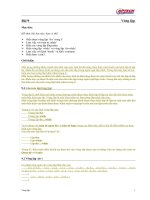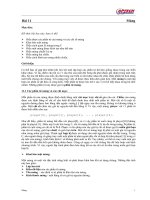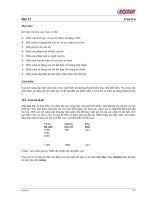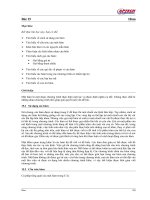Computer concept 2018 module10
Bạn đang xem bản rút gọn của tài liệu. Xem và tải ngay bản đầy đủ của tài liệu tại đây (778.83 KB, 76 trang )
Computer Concepts 2018
Module 10
Databases
Copyright © 2019 Cengage. All rights reserved.
Module Contents
•
•
•
•
•
Section A: Database Basics
Section B: Database Tools
Section C: Database Design
Section D: SQL
Section E: Big Data
© 2019 Cengage. All rights reserved.
Section A: Database Basics
•
•
Operational and Analytical Databases
Database Models
© 2019 Cengage. All rights reserved.
Section A: Objectives
•
•
•
•
•
Describe the difference between an operational database and an analytical database
•
Diagram the data structure for hierarchical, graph, relational, multidimensional, and object
database models
List seven activities associated with operational databases
Provide at least three examples of analytics applied to databases
Draw the data structure for a flat file and label each component
Draw ERDs and provide real-life examples of one-to-one, one-to-many, and many-tomany relationships
© 2019 Cengage. All rights reserved.
Operational and Analytical Databases (1 of 8)
•
•
An operational database is used to collect, modify, and maintain data on a daily basis
An analytical database is used to collect data that will be used for spotting trends that offer
insights for tactical and strategic business decisions
© 2019 Cengage. All rights reserved.
Operational and Analytical Databases (2 of 8)
•
Operational Databases
–
–
–
Operational databases are commonly part of an enterprise’s TPS, OLTP, CRM, SCM, or ERP
information systems.
They store data as it is collected from point-of-sale systems, customer loyalty programs, social
media signups, and other transactions.
The data is typically dynamic. It changes constantly and reflects up-to-the-minute information.
© 2019 Cengage. All rights reserved.
Operational and Analytical Databases (3 of 8)
•
Analytical Databases
–
–
–
Analytical databases commonly hold historical data copied from one or more transaction processing
systems.
Unlike an operational database, the data in an analytical database is not being constantly updated.
Therefore, it remains relatively static.
Because the data is historical, the information that can be inferred is like a snapshot of a point in
time.
© 2019 Cengage. All rights reserved.
Operational and Analytical Databases (4 of 8)
•
Operational databases perform the following:
–
–
–
–
–
–
–
Collect and store data
View data
Find data
Update data
Organize data
Distribute data
Move or remove data
© 2019 Cengage. All rights reserved.
Operational and Analytical Databases (5 of 8)
•
Analytical databases store data that is used by corporate executives, strategic planners, and
other workers to examine business metrics
•
Decision makers can access analytical databases using an executive dashboard, provided by
software such as iDashboards, which uses tools for visually displaying query results
© 2019 Cengage. All rights reserved.
Operational and Analytical Databases (6 of 8)
© 2019 Cengage. All rights reserved.
Operational and Analytical Databases (7 of 8)
•
Analytical databases perform the following:
–
–
–
Find relationships and patterns using data mining
Make predictions using predictive analytics
Examine multiple factors using OLAP (online analytical processing)
© 2019 Cengage. All rights reserved.
Operational and Analytical Databases (8 of 8)
© 2019 Cengage. All rights reserved.
Database Models (1 of 13)
•
•
The underlying structure of a database is referred to as a database model
One of the simplest models for storing data is a flat file that consists of a single, two-dimensional
table of data elements
•
Spreadsheets are stored as flat files displayed as rows and columns
© 2019 Cengage. All rights reserved.
Database Models (2 of 13)
© 2019 Cengage. All rights reserved.
Database Models (3 of 13)
•
•
•
•
A field contains the smallest unit of meaningful information; it is the basic building block for a
structured file or database
A variable-length field is like an accordion—it expands to fit the data you enter
A fixed-length field contains a predetermined number of characters (bytes)
In the world of databases, a record refers to a collection of data fields; the template for a record is
a record type
© 2019 Cengage. All rights reserved.
Database Models (4 of 13)
© 2019 Cengage. All rights reserved.
Database Models (5 of 13)
•
•
•
In database jargon, a relationship is an association between data that’s sorted in different record
types
An important aspect of the relationship between record types is cardinality, which refers to the
number of associations that can exist between two record types
The relationship between record types can be depicted graphically with an entity-relationship
diagram (sometimes called an ER diagram or ERD)
© 2019 Cengage. All rights reserved.
Database Models (6 of 13)
© 2019 Cengage. All rights reserved.
Database Models (7 of 13)
•
•
Many database models keep track of relationships among data, but there are different techniques
for doing so
A hierarchical database allows one-to-one and one-to-many relationships that are linked in a
hierarchical structure
© 2019 Cengage. All rights reserved.
Database Models (8 of 13)
© 2019 Cengage. All rights reserved.
Database Models (9 of 13)
•
A graph database offers an
alternative way to track
relationships; its structure
resembles sociograms with their
interlinked nodes
© 2019 Cengage. All rights reserved.
Database Models (10 of 13)
•
•
•
A relational database stores data in a collection of related tables
Each table is a sequence of records, similar to a flat file
A multidimensional database organizes relationships over three or more dimensions; in the
context of databases, a dimension is a layer based on a data element, such as a product, place,
or customer, that can be used to categorize data
© 2019 Cengage. All rights reserved.
Database Models (11 of 13)
© 2019 Cengage. All rights reserved.
Database Models (12 of 13)
•
•
•
•
An object database, also called an object-oriented database, stores data as objects, which can
be grouped into classes and defined by attributes and methods
Object databases excel at representing objects that have slightly different attributes, which is the
case in many real-world business applications
A document-oriented database stores unstructured data, such as the text of a speech
XML (eXtensible Markup Language) is a popular tool used to format document databases
© 2019 Cengage. All rights reserved.
Database Models (13 of 13)
An object database can easily store data about different types of orders. A class called Orders holds data and methods common to all types of orders. A
derivative class called Phone Orders inherits all the characteristics of Orders, but it has attributes and methods unique to orders placed by telephone. Web
Orders is a derivative class that has attributes and methods unique to orders placed over the Web.
© 2019 Cengage. All rights reserved.









